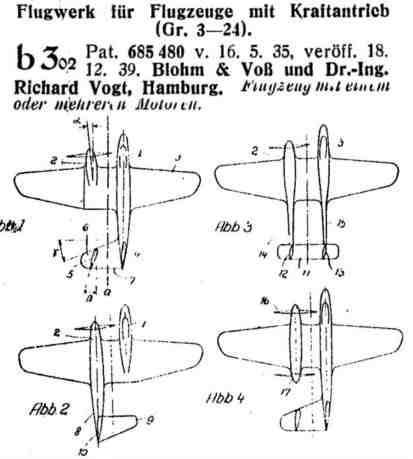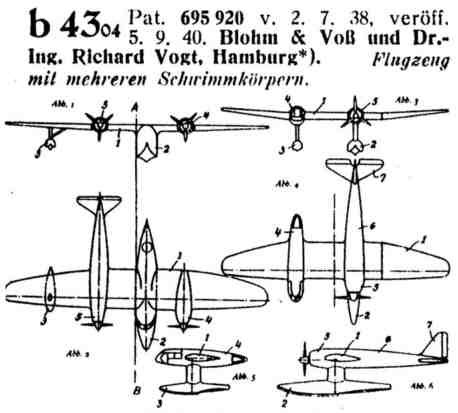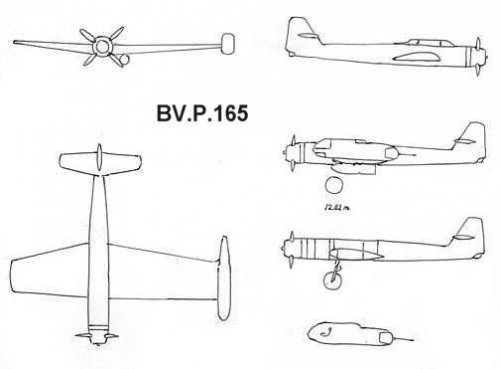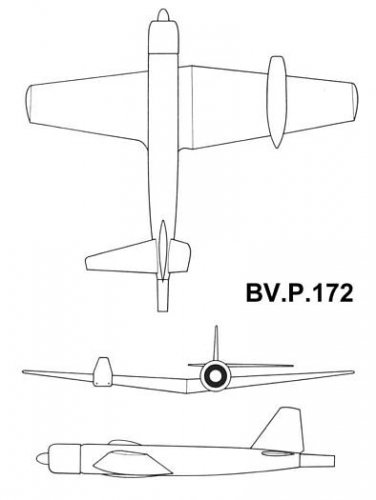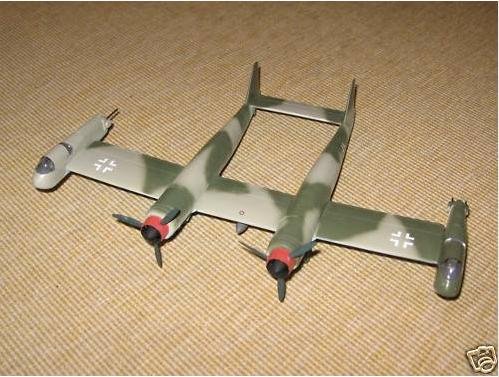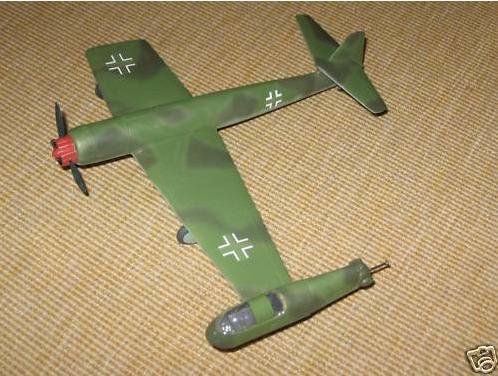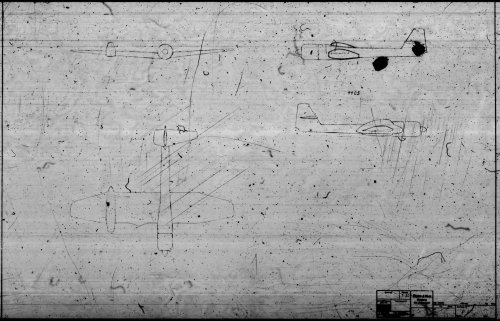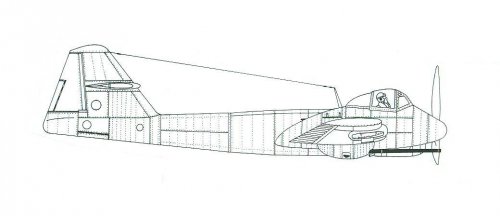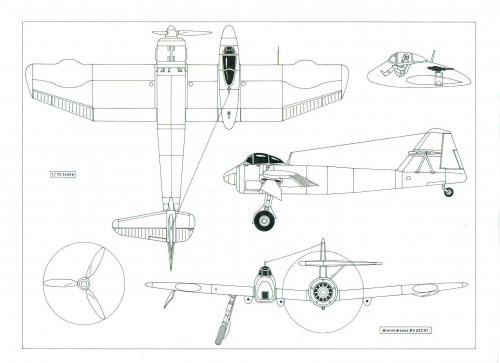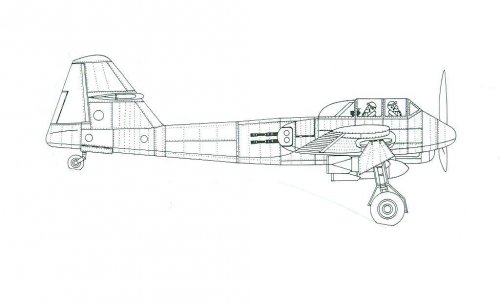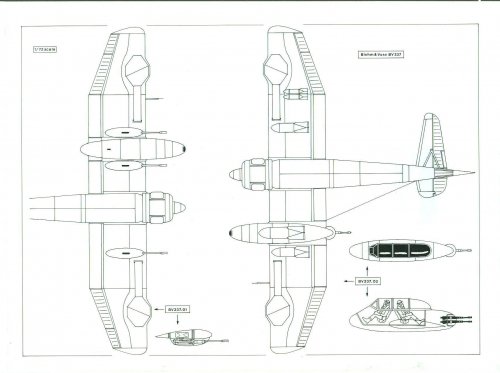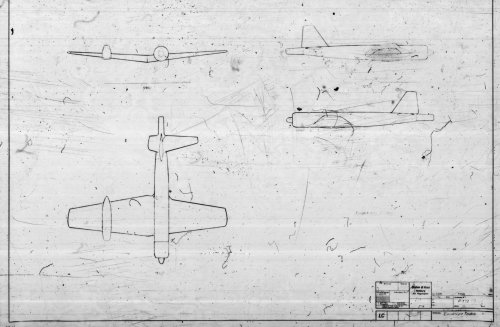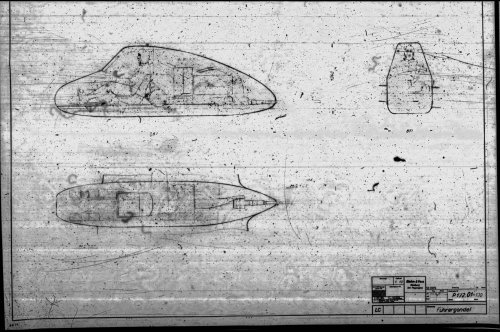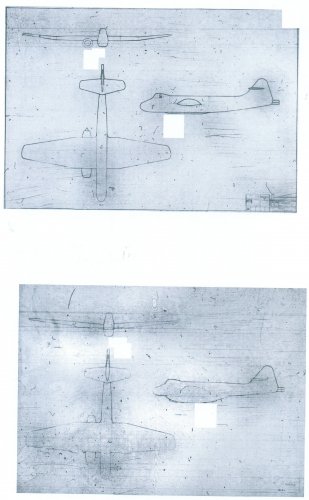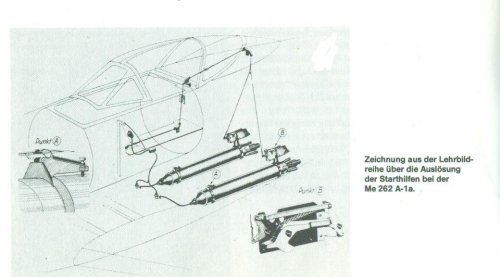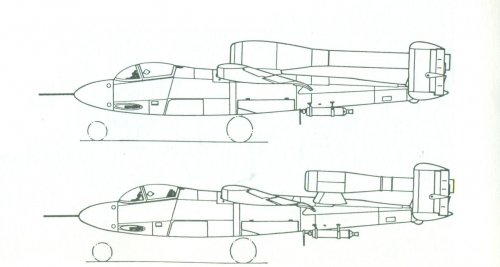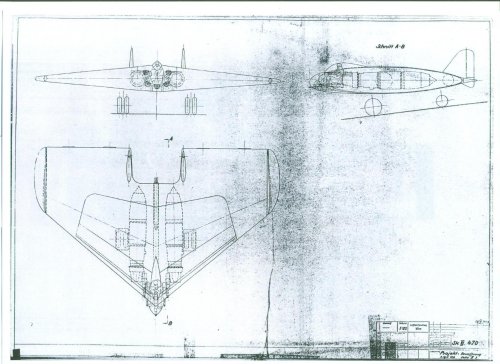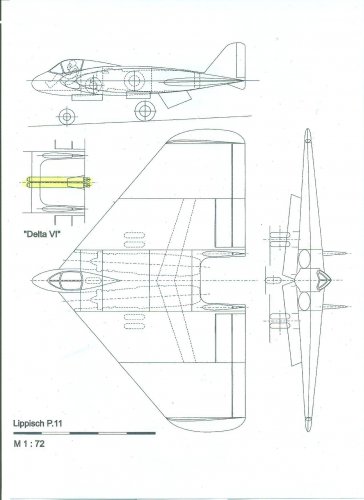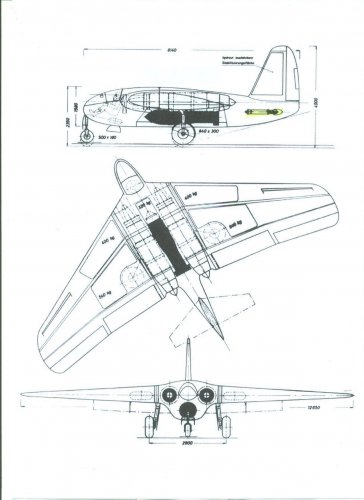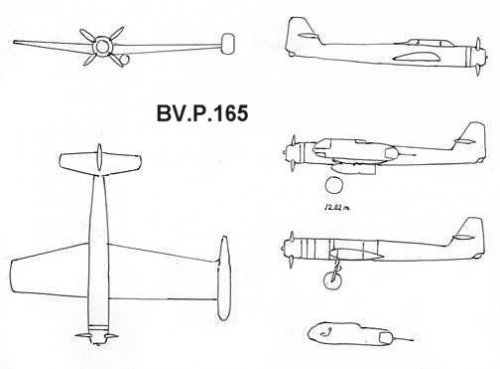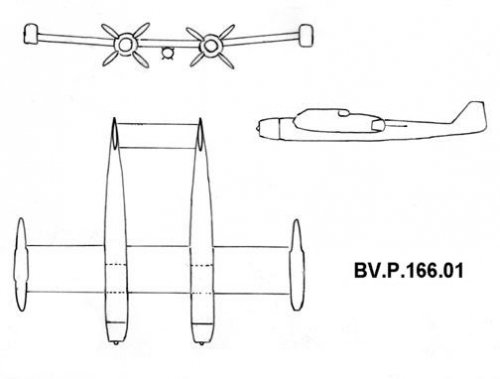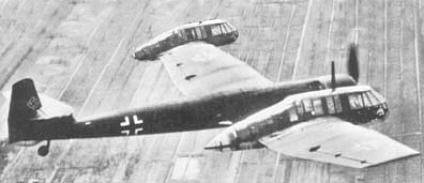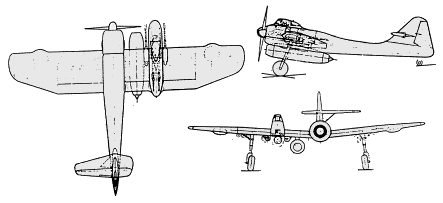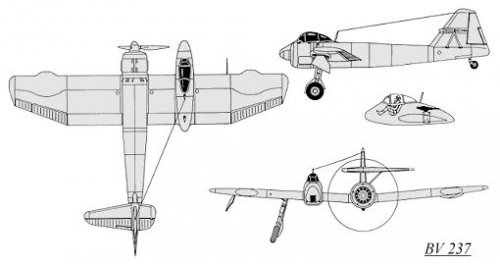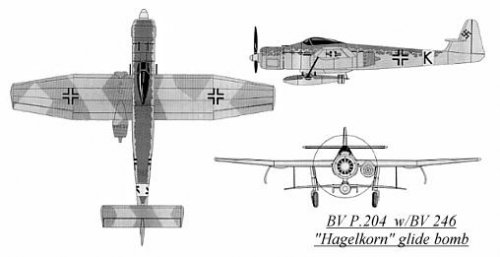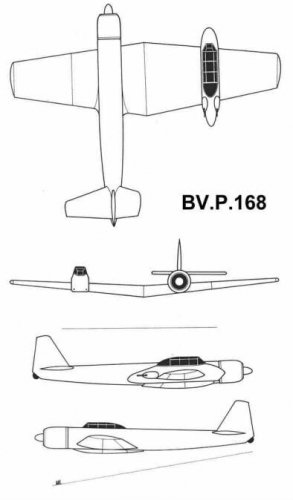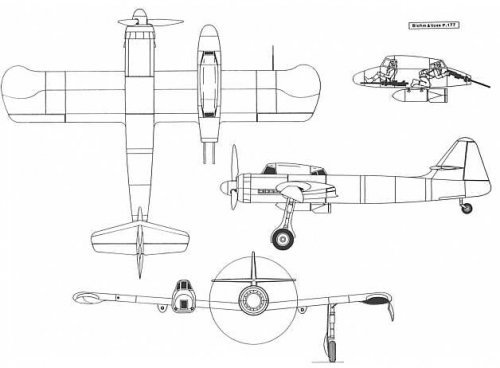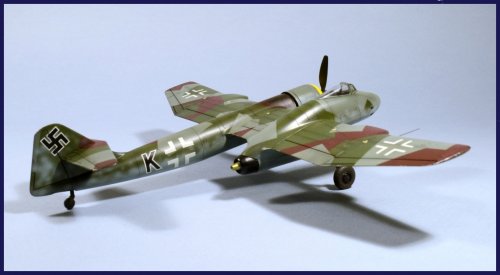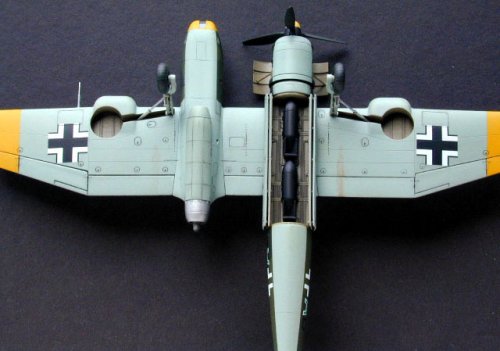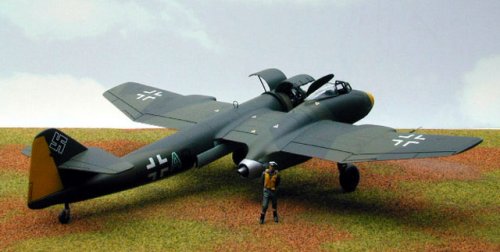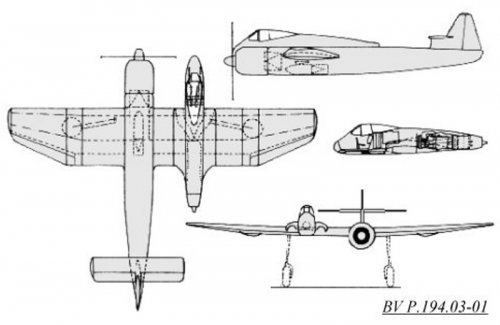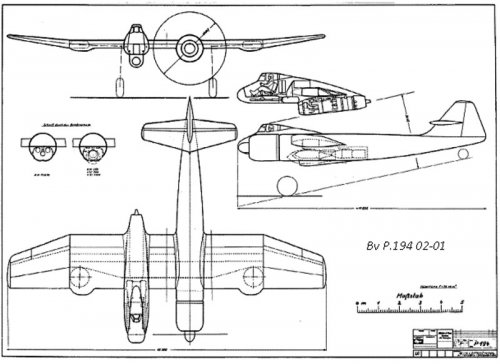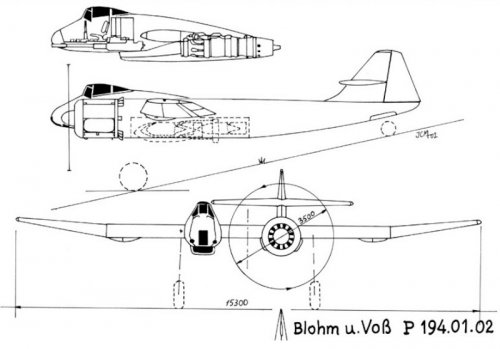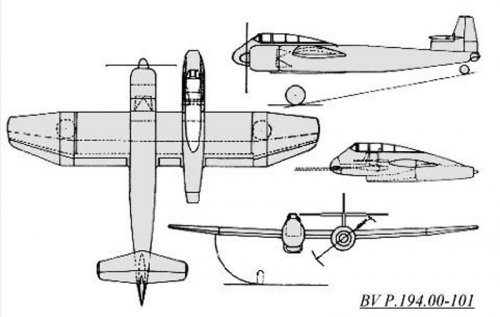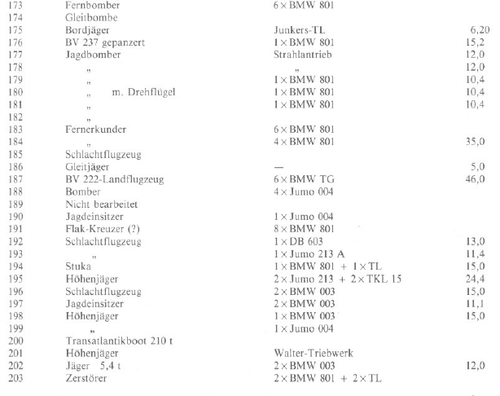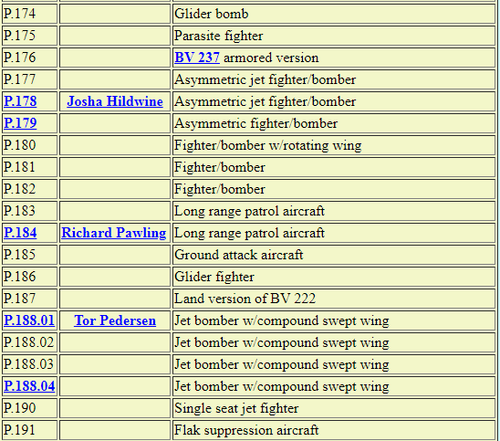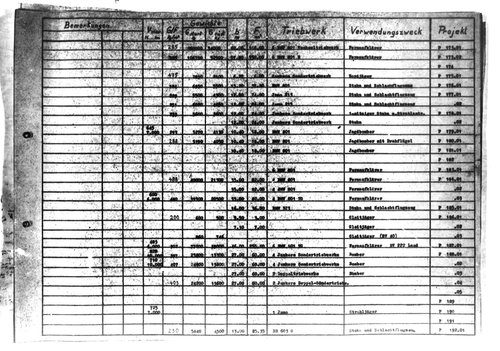You are using an out of date browser. It may not display this or other websites correctly.
You should upgrade or use an alternative browser.
You should upgrade or use an alternative browser.
Blohm und Voss Asymmetric Projects
- Thread starter hesham
- Start date
- Joined
- 26 May 2006
- Messages
- 34,917
- Reaction score
- 15,791
Blohm and Voss P.165 & P.166
Hi,
http://cgi.ebay.com/Blohm-Voss-BVP-165-1-72-Bird-Models-resin-kit-new-/230413328178?cmd=ViewItem&pt=UK_ToysGames_ModelKits_ModelKits_JN&hash=item35a5b45f32#ht_548wt_896
http://cgi.ebay.com/Blohm-Voss-BVP-166-1-72-Resinbausatz-Bird-Models-neu-/230487861360?cmd=ViewItem&pt=Standmodelle_Baus%C3%A4tze&hash=item35aa25a870#ht_1473wt_879
Hi,
http://cgi.ebay.com/Blohm-Voss-BVP-165-1-72-Bird-Models-resin-kit-new-/230413328178?cmd=ViewItem&pt=UK_ToysGames_ModelKits_ModelKits_JN&hash=item35a5b45f32#ht_548wt_896
http://cgi.ebay.com/Blohm-Voss-BVP-166-1-72-Resinbausatz-Bird-Models-neu-/230487861360?cmd=ViewItem&pt=Standmodelle_Baus%C3%A4tze&hash=item35aa25a870#ht_1473wt_879
Attachments
- Joined
- 27 December 2005
- Messages
- 17,752
- Reaction score
- 26,458
Re: Blohm and Voss P.165 & P.166
Again, just somewhat nasty looking model kits.
Again, just somewhat nasty looking model kits.
- Joined
- 13 August 2007
- Messages
- 8,456
- Reaction score
- 11,039
two ideas
BV-237 a fighter based on BV-141 design
P.194 design for Stuka bomber/fighter
Source:
Die Deutsche Luftrüstung 1933-1945
Band 1 Flugzeugtypen AEG - Dornier
by Heinz J. Nowarra
Page 115 and 132
BV-237 a fighter based on BV-141 design
P.194 design for Stuka bomber/fighter
Source:
Die Deutsche Luftrüstung 1933-1945
Band 1 Flugzeugtypen AEG - Dornier
by Heinz J. Nowarra
Page 115 and 132
I disagree, in my opinion the unknown project is a midget attack variant of the BV 141 standard with 11,05 m. lenght and 13,63 m span. ,please see wing planform comparative.
- Joined
- 11 March 2006
- Messages
- 8,625
- Reaction score
- 3,807
I think, too, that it is a modification of a then already existing design, because of the
protruding leading edge, where the nacelle was on the Bv 141. The wing planform resembles
the Bv 141B, the larger fin may have been used to compensate for the nacelle set even
further out from the centerline.
AFAIK the reason for those designs just was a better visibility and better field of fire for the
flexible weapons and the fact, that problems due to the asymmetry could be solved with relative
ease. For the fighter/attack variants, additional advantages were seen for placing fixed
weapons, which didn't need synchronisation
protruding leading edge, where the nacelle was on the Bv 141. The wing planform resembles
the Bv 141B, the larger fin may have been used to compensate for the nacelle set even
further out from the centerline.
AFAIK the reason for those designs just was a better visibility and better field of fire for the
flexible weapons and the fact, that problems due to the asymmetry could be solved with relative
ease. For the fighter/attack variants, additional advantages were seen for placing fixed
weapons, which didn't need synchronisation
richard
ACCESS: Top Secret
- Joined
- 1 May 2006
- Messages
- 578
- Reaction score
- 144
At first , thank you for all the B&V designs you have posted here : it's great you shared them 
About this project , the main feature is the big distance between the engine and the nacelle : it's like the P.168 and the P.172 .
The P.172-01-01 is illustrated in " Stukas ! " by Herbert Leonard (a very interesting book (in french) describing the german dive bombers from 1933 to 1945 , with many projects): it's not our mystery bird .
The P.172-02-01 is only described , but all fit well : BMW 801D , single seat , right wing much bigger than the left one , same tail wheel than the P.168...
About this project , the main feature is the big distance between the engine and the nacelle : it's like the P.168 and the P.172 .
The P.172-01-01 is illustrated in " Stukas ! " by Herbert Leonard (a very interesting book (in french) describing the german dive bombers from 1933 to 1945 , with many projects): it's not our mystery bird .
The P.172-02-01 is only described , but all fit well : BMW 801D , single seat , right wing much bigger than the left one , same tail wheel than the P.168...
- Joined
- 13 August 2007
- Messages
- 8,456
- Reaction score
- 11,039
i look closer on this Scan
wat i can see on Project number is P 1/2 or P. 1/7 (/ is a long scartch on Microfilm). also is the number 1105 clear to see
it could be that is label as P. 172
wat i can see on Project number is P 1/2 or P. 1/7 (/ is a long scartch on Microfilm). also is the number 1105 clear to see
it could be that is label as P. 172
P.168 ....please see http://www.geocities.ws/asymmetrics/bv 168.htm
mrys
ACCESS: Confidential
Justo Miranda said:P.168 ....please see http://www.geocities.ws/asymmetrics/bv 168.htm
P.168 has cockpit for two persons. This one looks like for pilot alone - P.172 rather.
- Joined
- 13 August 2007
- Messages
- 8,456
- Reaction score
- 11,039
Thx Kiradog for close up of the Scan
i try to photoshop it if discover there more written, but sadly mostly unreadable.
the Number is P.1 scratch 7 and n or m and on far end a 1
after study closely the book
Die Deutsche Luftrüstung 1933-1945
Band 1 Flugzeugtypen AEG - Dornier
by Heinz J. Nowarra
i found this: B&V P.177
Development of asymmetric one seat Fighter-bomber with one Jumo 213 with 1750 hp.
Armament 6x 20 mm MG 151/20 in Cockpit (what let to the BV 237 study)
i try to photoshop it if discover there more written, but sadly mostly unreadable.
the Number is P.1 scratch 7 and n or m and on far end a 1
after study closely the book
Die Deutsche Luftrüstung 1933-1945
Band 1 Flugzeugtypen AEG - Dornier
by Heinz J. Nowarra
i found this: B&V P.177
Development of asymmetric one seat Fighter-bomber with one Jumo 213 with 1750 hp.
Armament 6x 20 mm MG 151/20 in Cockpit (what let to the BV 237 study)
kiradog said:Here is what I have on the P.172
Did this have Pulse Jet assist?
Looked through my files and nothing on the P.177
Gary
Or solid fuel rockets
Attachments
- Joined
- 13 August 2007
- Messages
- 8,456
- Reaction score
- 11,039
the P.172 had a rocket engine in tail section (Walter Engine ?)
for boost fast take off, for interception or if Airbase is under attack.
source
Die Deutsche Luftrüstung 1933-1945
Band 1 Flugzeugtypen AEG - Dornier
by Heinz J. Nowarra
for boost fast take off, for interception or if Airbase is under attack.
source
Die Deutsche Luftrüstung 1933-1945
Band 1 Flugzeugtypen AEG - Dornier
by Heinz J. Nowarra
- Joined
- 11 March 2006
- Messages
- 8,625
- Reaction score
- 3,807
AFAIK, the Schmidding solid fuel boosters had a very short duration of a few seconds only
and so they were used as jettisonable take-off boosters, as it would have made not much
sense, to keep the burned out shells. Here it seems to be installed in the rear fuselage, so
I would think, it was a liquid fueled rocket engine.
and so they were used as jettisonable take-off boosters, as it would have made not much
sense, to keep the burned out shells. Here it seems to be installed in the rear fuselage, so
I would think, it was a liquid fueled rocket engine.
- Joined
- 13 August 2007
- Messages
- 8,456
- Reaction score
- 11,039
Jemiba said:AFAIK, the Schmidding solid fuel boosters had a very short duration of a few seconds only
and so they were used as jettisonable take-off boosters, as it would have made not much
sense, to keep the burned out shells. Here it seems to be installed in the rear fuselage, so
I would think, it was a liquid fueled rocket engine.
See as example, the Me 262-C Heimatschutzer I, II, III
in I version a Walter HWK 509 A-2 rocket engine was build into rear end.
it could fit in "cylinder" who stick out from P.172 tail unit
edit: the P.172 is a Stuka dive bomber, this cylinder must be part air brakes
sorry for that error
assymetrics air brakes? :
- Joined
- 11 March 2006
- Messages
- 8,625
- Reaction score
- 3,807
Michel might be right in relation to the fuselage they would be symmetric. Could be a
system similar to that of the Dornier Do 217, although the experiences weren't that
good, IIRC.
system similar to that of the Dornier Do 217, although the experiences weren't that
good, IIRC.
The tail drive brake of the Ar 240 V4 did not work well as well and both this and the Do 217 were symmetric planes.
- Joined
- 13 August 2007
- Messages
- 8,456
- Reaction score
- 11,039
Re: Blohm and Voss P.165 & P.166
Blohm & Voss tested the wingtip Cockpit at a BV141 (fly with two cockpits ! )
After those test they abandoned the Wingtip Cockpit concept fast
stop work on P.165 & P.166 and went on with P.177, P.204 and P.237 design.
According some stories was Göring outrage about the asymmetric design of Dr. Richard Vogt...
Blohm & Voss tested the wingtip Cockpit at a BV141 (fly with two cockpits ! )
After those test they abandoned the Wingtip Cockpit concept fast
stop work on P.165 & P.166 and went on with P.177, P.204 and P.237 design.
According some stories was Göring outrage about the asymmetric design of Dr. Richard Vogt...
Attachments
blackkite
Don't laugh, don't cry, don't even curse, but.....
- Joined
- 31 May 2007
- Messages
- 8,819
- Reaction score
- 7,721
Re: Blohm and Voss P.165 & P.166
Super picture! Thanks a lot. (What is the meaning of "Artwork by Igor Shestakov"? )
Also P.168 was almost same shape compared with P.177.
http://www.oocities.org/asymmetrics/bv168.htm
Luft46
"Additional versions included a two seat cockpit, and even a provision was made for a single Jumo 004 jet engine to be mounted beneath the wing between the fuselage and cockpit. Although a wooden mockup was constructed, the unusual asymmetric design was not accepted, plus there was really no need for a new ground attack/dive bomber this late in the war. "
https://www.youtube.com/watch?v=ubd0fAayVS4
Super picture! Thanks a lot. (What is the meaning of "Artwork by Igor Shestakov"? )
Also P.168 was almost same shape compared with P.177.
http://www.oocities.org/asymmetrics/bv168.htm
Luft46
"Additional versions included a two seat cockpit, and even a provision was made for a single Jumo 004 jet engine to be mounted beneath the wing between the fuselage and cockpit. Although a wooden mockup was constructed, the unusual asymmetric design was not accepted, plus there was really no need for a new ground attack/dive bomber this late in the war. "
https://www.youtube.com/watch?v=ubd0fAayVS4
Attachments
blackkite
Don't laugh, don't cry, don't even curse, but.....
- Joined
- 31 May 2007
- Messages
- 8,819
- Reaction score
- 7,721
Bv P.194.
https://en.wikipedia.org/wiki/Blohm_%26_Voss_P.194
"P.194.00-101 version with 16 m (52 ft) wingspan and jet intake under cockpit pod
P.194.01-02 version with 15.3 m (50.2 ft) wingspan, bubble canopy and jet intake under cockpit pod
P.194.02-01 as above, but with turbojet located beneath cockpit
P.194.03-01 as P.194.01-02, but with jet intakes located in the wing roots at the sides of the cockpit pod."
Russian site.
Justo-san's many amazing drawings here.
http://alternathistory.com/proekt-asimmetrichnogo-samoleta-blohm-voss-bv-p194
"In March 1944 onwards, Blohm Voss & Rejhcministerstvu aviation offer new project asymmetric aircraft which could be used as a fighter, attack aircraft, bombers and reconnaissance aircraft. Blohm Voss worked on & BV 237 and BV P. 179, two other asymmetric projects diploma Engineer Richard Vogt (Richard Vogt). However, this project was different from others in that they intend to use a mixed scheme of the engine, and propeller and Jet engine, plus domestic accommodation bomb loads in the main fuselage. This made it possible to offset the main disadvantage of the first jet engines-small cravings, and as a result low tâgovooružënnosti-bad landing runway and exceptional characteristics. Jet engine had to be placed in the gondola, and the internal placement of bombs in fûzelâžnom bombootseke allowed to keep high speed even with bomb load. Here is an excerpt from the original proposal Blohm Voss &: "this scheme gives an asymmetric plane many advantages, the primary is a good view from the cockpit, as well as the possibility of a large concentration of armament in the nose of the fuselage. This scheme reduces the torque produced around a vertical axis propeller if you use one of the traditional engine. On takeoff this time is expected to be less than half of such on the BV 141. After the take-off time is reduced to less than one third, and completely disappears during high-speed cruising.
In total there were four versions of the project BV p. 194, the constructive scheme of all remained unchanged. Due to the fact that the project had been proposed by 194 P at the end of the war, he received no further development."(Auto translation)
Revell model instruction manual for P.194.02-01. Wing leading edge shape is impressive. ;D
http://manuals.hobbico.com/rvl/80-4335.pdf
https://en.wikipedia.org/wiki/Blohm_%26_Voss_P.194
"P.194.00-101 version with 16 m (52 ft) wingspan and jet intake under cockpit pod
P.194.01-02 version with 15.3 m (50.2 ft) wingspan, bubble canopy and jet intake under cockpit pod
P.194.02-01 as above, but with turbojet located beneath cockpit
P.194.03-01 as P.194.01-02, but with jet intakes located in the wing roots at the sides of the cockpit pod."
Russian site.
Justo-san's many amazing drawings here.
http://alternathistory.com/proekt-asimmetrichnogo-samoleta-blohm-voss-bv-p194
"In March 1944 onwards, Blohm Voss & Rejhcministerstvu aviation offer new project asymmetric aircraft which could be used as a fighter, attack aircraft, bombers and reconnaissance aircraft. Blohm Voss worked on & BV 237 and BV P. 179, two other asymmetric projects diploma Engineer Richard Vogt (Richard Vogt). However, this project was different from others in that they intend to use a mixed scheme of the engine, and propeller and Jet engine, plus domestic accommodation bomb loads in the main fuselage. This made it possible to offset the main disadvantage of the first jet engines-small cravings, and as a result low tâgovooružënnosti-bad landing runway and exceptional characteristics. Jet engine had to be placed in the gondola, and the internal placement of bombs in fûzelâžnom bombootseke allowed to keep high speed even with bomb load. Here is an excerpt from the original proposal Blohm Voss &: "this scheme gives an asymmetric plane many advantages, the primary is a good view from the cockpit, as well as the possibility of a large concentration of armament in the nose of the fuselage. This scheme reduces the torque produced around a vertical axis propeller if you use one of the traditional engine. On takeoff this time is expected to be less than half of such on the BV 141. After the take-off time is reduced to less than one third, and completely disappears during high-speed cruising.
In total there were four versions of the project BV p. 194, the constructive scheme of all remained unchanged. Due to the fact that the project had been proposed by 194 P at the end of the war, he received no further development."(Auto translation)
Revell model instruction manual for P.194.02-01. Wing leading edge shape is impressive. ;D
http://manuals.hobbico.com/rvl/80-4335.pdf
Attachments
- Joined
- 11 March 2012
- Messages
- 3,251
- Reaction score
- 3,179
One disadvantage of assymetrical thrust is that the airplane yaws (turns) every time the pilot adjusts the throttle.
It gets even more complicated with two different types of power (e.g. B&V 204 with a jet engine under the right wing and a piston engine in the boom).
For example, when you slam the throttle on a piston engine, it increases power almost instantaineously .... albeit with a dose of yaw.
OTOH slamming the throttle on an early jet produces lacklustre acceleration ...... eventually ..... with zero yaw.
The worst case is slamming both throttles - on an assymetrically powered airplane with two different power plants - and having your airplane yaw all over the sky as you are trying to lay a gun sight on a fleeing foe.
It gets even more complicated with two different types of power (e.g. B&V 204 with a jet engine under the right wing and a piston engine in the boom).
For example, when you slam the throttle on a piston engine, it increases power almost instantaineously .... albeit with a dose of yaw.
OTOH slamming the throttle on an early jet produces lacklustre acceleration ...... eventually ..... with zero yaw.
The worst case is slamming both throttles - on an assymetrically powered airplane with two different power plants - and having your airplane yaw all over the sky as you are trying to lay a gun sight on a fleeing foe.
riggerrob said:One disadvantage of assymetrical thrust is that the airplane yaws (turns) every time the pilot adjusts the throttle.
True enough, but then again even an aircraft that looks symmetrical may not be so in practice, especially a single-engine propeller type because of the very asymmetrical propeller slipstream. Rudder and/or aileron trim changes with power and speed are not uncommon. Plus, just about every aircraft ever made is vertically asymmetrical, so pitch trim changes with power and speed are normal. By all accounts, the Blohm & Voss BV 141 was quite pleasant to fly.
- Joined
- 25 June 2009
- Messages
- 14,754
- Reaction score
- 6,155
Astounding models! It would be nice to have the source and/or the name of the builder(s)...
cluttonfred said:riggerrob said:One disadvantage of assymetrical thrust is that the airplane yaws (turns) every time the pilot adjusts the throttle.
True enough, but then again even an aircraft that looks symmetrical may not be so in practice, especially a single-engine propeller type because of the very asymmetrical propeller slipstream. Rudder and/or aileron trim changes with power and speed are not uncommon. Plus, just about every aircraft ever made is vertically asymmetrical, so pitch trim changes with power and speed are normal. By all accounts, the Blohm & Voss BV 141 was quite pleasant to fly.
Exactly. Single-engined, propeller-driven airplanes sometimes have offset vertical tails or longer wings or tailplanes on one side in order to counter torque.
I wonder if the B & V designs weren't conceived with single-engine ground handling in mind. The offset gondolas and the unusually wide, near wingtip undercarriages would resist torque and prevent ground loops on rough ground.
- Joined
- 26 May 2006
- Messages
- 34,917
- Reaction score
- 15,791
the Blohm and Voss
P.157 was a heavy fighter project.
All I remember this Info was in a reliable Model magazine,maybe; Scale Aviation Modeller International.
- Joined
- 11 June 2014
- Messages
- 1,542
- Reaction score
- 2,902
- Joined
- 26 May 2006
- Messages
- 34,917
- Reaction score
- 15,791
Nope. Blohm & Voss's own register of projects says the P 157 designation was unallocated.
View attachment 619913
My dear Dan,
I know you are expert in this field,but their list is not measure,no reason for slip some numbers,just the author
didn't know them or lost their reports,anther example for your list also,there was no P.174 & P.191,but in many
source they are known ?!.
Attachments
Last edited:
- Joined
- 11 June 2014
- Messages
- 1,542
- Reaction score
- 2,902
Nope. Blohm & Voss's own register of projects says the P 157 designation was unallocated.
View attachment 619913
My dear Dan,
I know you are expert in this field,but their list is not measure,no reason for slip some numbers,just the author
didn't know them or lost their reports,anther example for your list also,there was no P.174 & P.191,but in many
source they are known ?!.
Okay, let's unravel this. We're looking at three lists.
The list on Luft46.com is based on the one which appears on p122-123 of Heinz J. Nowarra's Die Deutsche Luftruestung 1933-1945 Vol. 1. 1993 version. I'll call this the 'Nowarra list'.
I have two wartime lists from T-2 microfilm obtained from NASM: One is handwritten onto printed sheets, with various different handwriting filling it in from P 1 to where it ends at P 208.02. This has no details other than project number, aircraft role and engine type used. I'll call this the 'handwritten list'.
The other list is the printed list I've uploaded a few sections from, which runs from P 1 up to P 212.01 and includes lots of other details including weights, wingspan etc. as you have seen. I'll call this the 'printed list'.
There are certain gaps in common with all three, a handful of instances where the Nowarra list has details the others lack, instances where the handwritten list has more detail and instances where the printed list has detail where the others don't.
There are 40 project numbers where one, two or all three lists have gaps as follows:
P 2 (gap on all three)
P 3 (gap on all three)
P 26 (gap on all three)
P 30 (gap on Nowarra and handwritten list, stats given on printed list)
P 31 (gap on Nowarra and handwritten list, stats given on printed list)
P 32 (gap on Nowarra and handwritten list, stats given on printed list)
P 34 (gap on all three)
P 35 (gap on Nowarra and handwritten list, Landmaschine Lufthansa in printed list)
P 36 (gap on Nowarra and handwritten list, Wassermachine Lufthansa in printed list)
P 87 (gap on all three)
P 91 (gap on all three)
P 93 (gap on Nowarra, ‘Aenderung der Nr. [illegible] P 96, P 103 on handwritten list, gap on printed list)
P 101 ('Zielflugzeug' in Nowarra, gap in both handwritten and printed lists)
P 102 (gap in all three)
P 106 (BV 222 development in Nowarra, ‘222’ with ‘?’ under engines in handwritten list, blank in printed list)
P 107 (BV 222 development in Nowarra, ‘222’ with ‘?’ under engines in handwritten list, blank in printed list)
P 120 (gap on all three)
P 121 (gap on all three)
P 129 ('Jagdeinsitzer' in Nowarra, gap in handwritten and printed lists)
P 130 (gap on all three)
P 132 (gap on all three)
P 133 (gap on all three)
P 136 (gap on all three)
P 137 (gap on all three)
P 139 ('Flugboot' in Nowarra, gap in handwritten and printed lists)
P 147 ('P 142 als Transporter' in Nowarra and handwritten list, gap in printed list)
P 148 ('Flugboot' in Nowarra, gap in handwritten and printed lists)
P 149 ('Flugboot' in Nowarra, gap in handwritten and printed lists)
P 151 (gap on all three)
P 152 (gap on all three)
P 153 (gap on all three)
P 154 (gap on all three)
P 156 (gap on all three)
P 157 (gap on all three)
P 158 (gap on all three)
P 159 (gap on all three)
P 174 ('Gleitbombe' in Nowarra and handwritten list, gap in printed list)
P 182 ('Jagdbomber' in Nowarra, blank in handwritten and printed lists)
P 189 (gap on all three)
P 191 ('Flak-Kreuzer (?)' in Nowarra, unclear on handwritten list but looks like Fernbomber with 8 x BMW 801 to me, blank on printed list)
Eliminating the 23 instances where all three agree, we're left with the following 17 points of disagreement:
P 30 (gap on Nowarra and handwritten list, stats given on printed list)
P 31 (gap on Nowarra and handwritten list, stats given on printed list)
P 32 (gap on Nowarra and handwritten list, stats given on printed list)
P 35 (gap on Nowarra and handwritten list, Landmaschine Lufthansa in printed list)
P 36 (gap on Nowarra and handwritten list, Wassermachine Lufthansa in printed list)
P 93 (gap in Nowarra, ‘Aenderung der Nr. [illegible] P 96, P 103 on handwritten list, gap on printed list)
P 101 ('Zielflugzeug' in Nowarra, gap in both handwritten and printed lists)
P 106 (BV 222 development in Nowarra, ‘222’ with ‘?’ under engines in handwritten list, blank in printed list)
P 107 (BV 222 development in Nowarra, ‘222’ with ‘?’ under engines in handwritten list, blank in printed list)
P 129 ('Jagdeinsitzer' in Nowarra, gap in handwritten and printed lists)
P 139 ('Flugboot' in Nowarra, gap in handwritten and printed lists)
P 147 ('P 142 als Transporter' in Nowarra and handwritten list, gap in printed list)
P 148 ('Flugboot' in Nowarra, gap in handwritten and printed lists)
P 149 ('Flugboot' in Nowarra, gap in handwritten and printed lists)
P 174 ('Gleitbombe' in Nowarra and handwritten list, gap in printed list)
P 182 ('Jagdbomber' in Nowarra, blank in handwritten and printed lists)
P 191 ('Flak-Kreuzer (?)' in Nowarra, unclear on handwritten list but looks like Fernbomber with 8 x BMW 801 to me, blank on printed list)
Looking a little more closely at these 17:
P 30 The printed list fails to give a role for this aircraft but gives the engines as 4 x Jumo 206, wing area 125m2 and a starting weight of 17,600kg.
P 31 Again, no role from the printed list but it does give the engine as Jumo 210. No wing area but starting weight was 2450kg.
P 32 No role or engine but wing area was 30m2 and starting weight was 6000kg.
P 35 The printed list gives only 'Landmaschine Lufthansa' with 4 x DB 601 and a top speed of 445km/h at 6000m.
P 36 The printed list gives 'Wassermaschine Lufthansa' with 4 x DB 601 and a top speed of 410km/h at 4000m.
P 93 One of very few instances where the handwritten list differs from Nowarra, this has only a tiny note on it which says ‘Aenderung der Nr. [illegible] P 96, P 103'
P 101 Clearly blank in both period lists. In Nowarra this is given as 'Dasselbe' below the P 100 Zielflugzeug but above the P 102 described as 'Nicht bearbeitet'. My guess would be that it should say 'Nicht bearbeitet' next to P 101 and 'Dasselbe' should be next to P 102 instead. Basically a simple typo.
P 106 The handwritten list has a very faintly pencilled in '222' on this one, with a question mark for the engines. The author clearly wasn't sure about this one.
P 107 The same faint '222' and '?' as P 106.
P 129 This appears to be another typo in Nowarra's list, as with the P 101. The P 130 is 'Nicht bearbeitet' and the P 128 is shown only as '"' from the P 127 Jagdeinsitzer.
P 139 Nowarra just gives this as 'Flugboot' where both period lists are blank. Perhaps some confusion with the Ha 139 - otherwise inexplicable.
P 147 This is blank on the printed list but the handwritten list does clearly have P 147 as 'P 142 als Transporter'.
P 148 Like P 139, Nowarra gives this simply as 'Flugboot' with no other details when both period lists have it as a gap. Inexplicable.
P 149 As with P 148 - Nowarra has no engine or wingspan data - he just gives 'Flugboot' where both period lists have a clear gap.
P 174 The handwritten list very clearly agrees with Nowarra where the printed list is blank - 'Gleitbombe'.
P 182 As with P 101 and P 129, I think this is a typo. It comes at the bottom of a very long list of '"' and probably ought to have been 'Nicht bearbeitet' instead.
P 191 Curiously described by Nowarra as 'Flak-Kreuzer (?) 8 x BMW 801'. It is pretty unclear on the handwritten list, but it looks to me more like 'Fernbomber 8 x BMW 801'.
I would conclude that the Nowarra list is based on the T-2 captured 'handwritten list' but with a few basic inaccuracies where the information hasn't been transcribed correctly. The 'handwritten list' itself is, as noted, in a number of different hands and gets visibly scrappier as it gets towards the end. I would guess that this was the ongoing company list, which stopped being updated after the P 208.02. The printed list is much more useful because it includes lots more technical detail but it does exclude more projects than the handwritten list. This might be because the files had been lost, as you suppose. Perhaps it was intended to replace the scrappy handwritten list and was produced as work was being carried out on the P 208.02 in the autumn of 1944. The fact remains, however, that Blohm & Voss clearly did not use every number they could have used for their projects. At least 23 went unused and we will probably never know why. And P 157 was among them.
Last edited:
Similar threads
-
-
-
Asymmetric aircraft drawings from Flight 1942
- Started by hesham
- Replies: 5
-
-

